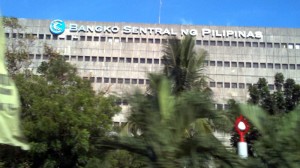BSP seen raising bank reserves anew
The central bank is expected to do more of the same at the Monetary Board’s policy meeting this week as officials’ eyes remain fixed on mopping up excess cash from the system to quell the threat this poses to price stability.
Five banks polled by the Inquirer were unanimous in saying the Bangko Sentral ng Pilipinas (BSP) would likely ask banks to set aside more of their deposits as reserves, keeping this cash from entering the economy and fueling excess demand that, in turn, causes inflation to spike.
“There’s a lot more cash that was let loose that still has to be siphoned off,” Security Bank executive vice president Rafael Algara told the Inquirer in an interview.
Another one percentage-point increase in the reserve requirement, as the BSP did late last March, is expected to suck up an estimated P60 billion in liquidity—cash that would no longer be available for loans to either businesses or households. Having less cash available for lending will push up the cost of borrowing, tempering consumer demand.
Apart from Algara, analysts from Metropolitan Bank and Trust Co., Bank of the Philippine Islands, BDO Unibank and Barclays all said the BSP would increase the reserve requirement for banks. At the moment, universal and commercial banks are required to set aside 19 percent of their clients’ deposits as reserves.
Article continues after this advertisementAll banks said the BSP would keep its benchmark rates at their record lows until the second half of the year or early 2015.
Article continues after this advertisementThe average rise in consumer prices likely accelerated to 4.1 percent in April from 3.9 percent the month before, a report by Metrobank said last week. This was in line with the BSP’s forecast for the month of 3.6 to 4.5 percent.
For the whole year, the BSP expects inflation to average 4.2 percent, significantly faster than last year’s 3 percent and above the midpoint of the central bank’s 3- to 5-percent target range.
“The BSP will remain watchful of potential financial stability pressures from liquidity and credit growth, especially as these may be affected by global developments,” BSP Governor Amando M. Tetangco Jr. said in a previous statement.
Growth in domestic liquidity rose by a record 37.3 percent in January this year, a result mainly of the ban on non-pooled funds from the BSP’s special deposit accounts (SDAs) that took effect last November. In March, liquidity growth slowed down to a still-elevated 34.8 percent. Bank lending also rose by 20 percent in March, speeding up from 19.4 percent the month before.
American banking giant Citibank also predicted that the BSP might further tighten monetary settings this week with another one percentage-point increase in the reserve requirement to ward off inflationary pressures.
Citi economist for the Philippines Jun Trinidad said in a research note issued on Friday that he was expecting the BSP’s Monetary Board to increase the reserve requirement on banks to 20 percent during its meeting on May 8.
“We sense policymakers to remain uneasy with M3 (domestic liquidity) expanding by over 30 percent year-on-year for the ninth straight month amid strong growth momentum and inflation firming up at 4 percent or more,” Trinidad said.
M3 is the broadest measure of liquidity or money supply in an economy. It includes deposit, deposit substitutes, large time deposits, institutional money market funds, short-term repurchase agreements and other larger liquid assets.
Trinidad said the country’s nominal growth backdrop of 10 percent or so would not require funding or liquidity growth at a sustained rate of over 30 percent.
“Households/businesses may get accustomed to ‘excessive liquidity’ and sustained access could affect inflation expectations,” Trinidad said. “Tightening liquidity imbalances that would not unduly threaten an upbeat growth backdrop would require non-interest rate tools.”
Trinidad estimated that another round of reserve increases would drain a cumulative P120 billion from the system, equivalent to 4 percent of M3.
“With this cumulative impact, markets would start to feel the reserve hike ‘pinch’ and uplift bank lending rates and other market rates,” he said.
He noted that the BSP’s decision last March 27 to raise bank reserves by 1 percentage point—with a potential drain of P60 billion—has yet to be reflected in the latest M3 report as this became effective only on April 4.
Trinidad said the easing of M3 in March implied that the effect of the special deposit account (SDA) phaseout peaked in January when the country’s M3 posted a 37.3 percent growth. But he added that this would not derail another bank reserve adjustment this month.
Against the backdrop of robust deposit growth, Trinidad noted that currency in circulation had eased with an 8.3-percent year-on-year growth that mitigated the spillover of excess liquidity to inflation risk.
On the potential impact of another reserve requirement increase on financial markets, Trinidad said investors could find safe refuge in short-term bonds.
“Preference for short-duration bonds remains as sanctuary from BSP’s tightening moves capped by rate hikes in second half of 2014,” he said.
